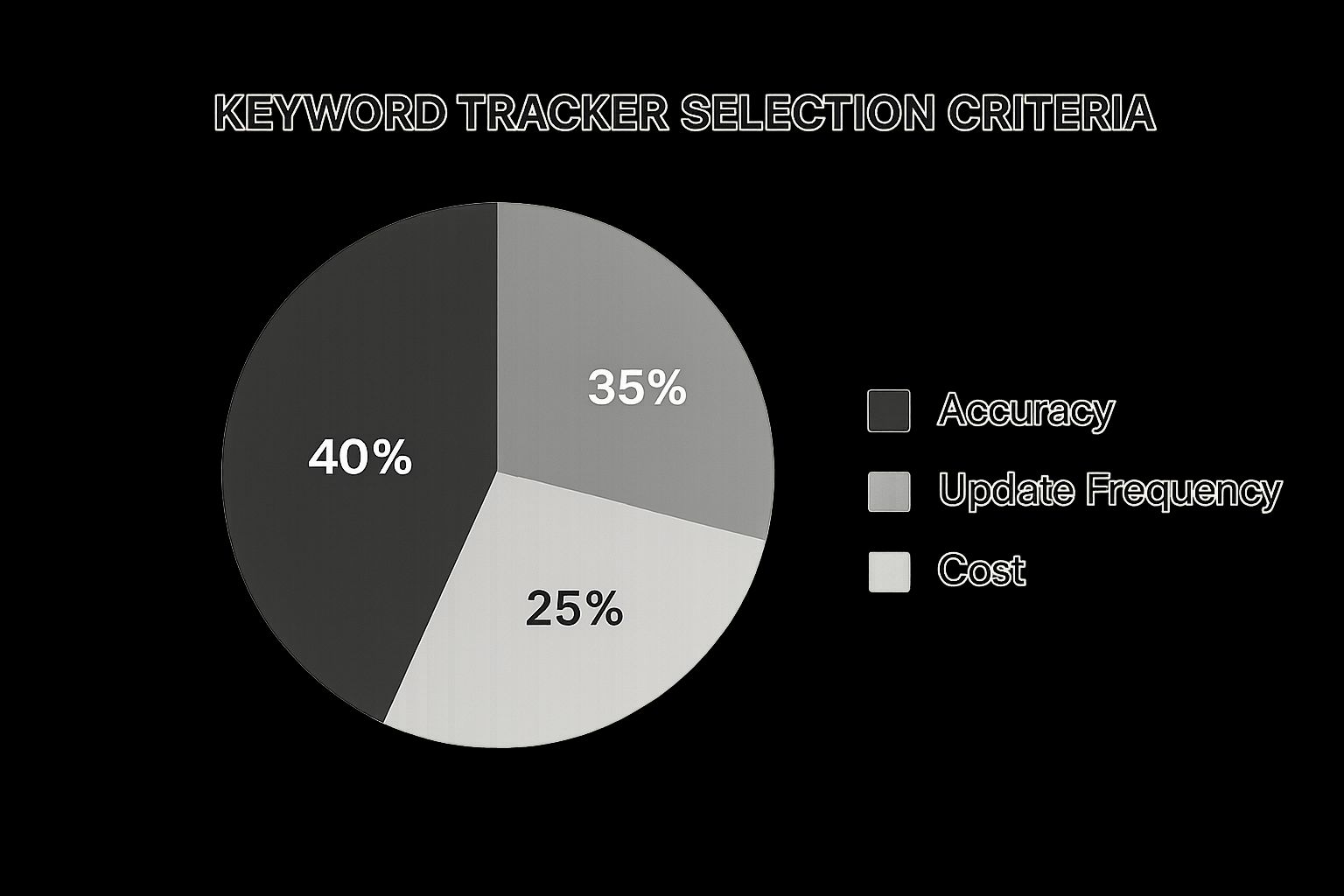Understanding Keyword Rank Trackers (And Why They Matter)
Trying to do SEO without tracking your keywords is like sailing across an ocean with no map or compass. You might be moving, but you have no idea if you're heading in the right direction. A keyword rank tracker is that essential navigation tool for your website, showing you exactly where you stand for the search terms that drive your business.
But its real value goes much deeper than a simple number on a chart. It’s about uncovering the story behind your rankings—a story about your SEO performance, your competitors' strategies, and new opportunities waiting to be claimed.
More Than Just a Number
By checking your rankings consistently, you start to see patterns emerge from the daily ups and downs. Each fluctuation is a piece of a larger puzzle. Did your ranking for a key term suddenly fall? This could be a clue that a Google algorithm update just rolled out, or that a competitor is making a big push.
On the flip side, did you just break into the top three spots for a more specific, long-tail keyword? That’s a clear signal your content is hitting the mark and it might be time to create more content around that topic. A quality rank tracker helps you see these trends over time, turning confusing data into a clear roadmap for your next steps.
Here’s a practical example. Imagine you get an alert that your main competitor just dropped from position #3 to #8 for a very valuable keyword. That isn't just an interesting fact; it's a golden opportunity. It tells you that right now is the perfect moment to publish a new article or refresh an old one to swoop in and take that spot. This is how you move from reacting to SEO to proactively shaping it.
From Local Clicks to Global Strategy
This kind of monitoring is valuable for any business, but for local companies, it’s a game-changer. Strong local SEO rankings can directly translate into real-world results. When you track local search terms, you’re really tracking your ability to generate more phone calls, website clicks, and actual foot traffic. As you can discover more insights on local ranking impact, a high rank in local search builds trust and gives you a serious edge in your community.
Ultimately, what you learn from your rank tracker should guide your entire marketing strategy. Knowing which keywords are gaining traction helps you make smarter decisions across all your digital marketing channels. For instance, why pour money into a social media campaign for a product page that’s invisible on Google? Your ranking data tells you where to focus your efforts for the biggest return.
This is why a reliable keyword rank tracker isn't just another tool or an expense. It's a fundamental investment in the sustainable growth of your business.
The Real Story Behind How Rank Trackers Work
 Ever wondered what really happens when you click the "track" button on a keyword? It's not magic, but it's a clever process. Think of a keyword rank tracker as a team of digital detectives sent to gather unbiased intelligence from search engines. Their mission is to report exactly where your website stands, free from any outside influence.
Ever wondered what really happens when you click the "track" button on a keyword? It's not magic, but it's a clever process. Think of a keyword rank tracker as a team of digital detectives sent to gather unbiased intelligence from search engines. Their mission is to report exactly where your website stands, free from any outside influence.
Simulating the User Experience
At its core, a rank tracker methodically checks search engines for your keywords. But it doesn't just type a word into a search bar. Instead, it sends automated queries from different servers, each set up to act like a real user in a very specific situation.
This simulation is the key to getting useful data. To get a true picture, the tool must define several important details for every check it runs:
- Geographic Location: Checking a keyword from a server in Dallas will show different local results than one in Miami.
- Device Type: The tool checks mobile and desktop rankings separately, as they are often completely different.
- Language: It ensures the query is sent to the correct regional version of the search engine (e.g., google.ca vs. google.co.uk).
The Battle for Accurate Data
The single biggest challenge for any rank tracker is search engine personalization. Google and other search engines tailor results based on a user's browsing history, location, and past behavior. A reliable rank tracker must bypass this personalization by using methods that pull clean, non-personalized search engine results pages (SERPs). This provides a true benchmark of your general visibility.
On top of that, SERPs are no longer just a list of ten blue links. Today's results are filled with features like Featured Snippets, "People Also Ask" boxes, and AI Overviews. An effective keyword rank tracker must be able to read this complex page layout and report your position within these valuable features, not just your standard organic rank.
This fight for precision is why data accuracy is such a major concern in the SEO tool industry. For instance, studies have found Google Keyword Planner to be only about 45% accurate in its search volume data. One analysis showed it overestimates volume for over 91% of keywords, which shows how even foundational data can be misleading. You can explore the full keyword research statistics here.
To get a real result, the tracker must make a query look like it came from a real person. For more ideas on how users search, particularly from a paid ads perspective that can inform your SEO strategy, check out this guide on Google Ads keyword research.
Understanding what happens behind the scenes is important. It clarifies why some tools deliver more dependable data than others and helps you read your ranking reports with a better sense of context. The number you see on your dashboard isn't just a number—it's the final piece of a complex operation designed to give you a clear view in a constantly moving environment.
Features That Separate Winners From Time-Wasters

Not all rank tracking tools are created equal. Imagine one tool is like your car's basic speedometer—it tells you that you rank at position #7. A professional-grade keyword rank tracker, however, is like a full GPS system with live traffic data; it not only shows your position but also reveals why you're there, what roadblocks are ahead, and the best alternative routes.
The difference can make or break your SEO strategy. It’s easy to get distracted by endless feature lists, but the real power comes from a few key capabilities that provide strategic direction, not just more data points to sift through.
To make sense of the options, it's helpful to compare what different tiers of tools offer. The following table breaks down the features you can expect, from basic trackers to enterprise-level platforms, and the business impact of each.
| Feature | Basic Tools | Professional Tools | Enterprise Tools | Business Impact |
|---|---|---|---|---|
| Accuracy & Updates | Often weekly or manual | Daily, automated updates | Daily or on-demand, high-accuracy checks | Timeliness. Daily data is crucial for reacting quickly to market shifts. |
| Competitor Tracking | 1-2 competitors, limited | 5-10+ competitors, keyword overlap analysis | Unlimited competitors, market share views | Competitive Edge. See rivals' strategies and find your unique opportunities. |
| SERP Feature Tracking | Organic ranks only | Tracks Snippets, PAA, Local Pack | Tracks all features, including AI Overviews | Visibility. Modern SEO is about winning valuable SERP real estate, not just links. |
| Local & Mobile Tracking | National-level only | City or ZIP code level tracking | Granular geo-targeting, device segmentation | Relevance. Reaching the right customers in the right location and on the right device. |
| Historical Data | 30-90 days of data | 1-2+ years of data, trend analysis | Unlimited history, API access for BI tools | Insight. Connect ranking changes to your actions and algorithm updates over time. |
| Reporting & Alerts | Manual exports (CSV) | Scheduled PDF reports, email alerts | Customizable dashboards, white-labeling, API | Efficiency. Automate communication with stakeholders and prove your value. |
As you can see, moving from a basic to a professional tool is less about getting more features and more about getting smarter, more actionable data. Enterprise tools take this a step further by integrating this intelligence directly into larger business operations.
Beyond the Basics: Core Strategic Capabilities
The most effective tools transform from simple measurement instruments into a command center for your SEO operations. They provide true strategic intelligence. Here are the capabilities that matter most:
- Competitor Intelligence: This isn't just about seeing who ranks above you. It’s about seeing which keywords your rivals are gaining or losing ground on. This insight reveals their strategic focus, showing you where to defend your turf or where to attack an unguarded flank.
- Historical Data View: Daily ranking fluctuations are mostly noise. The real story is in the long-term trends. Historical data helps you connect the dots between your content update in March and your ranking jump in April, or diagnose a drop that coincided with a major Google algorithm update.
- Local Rank Monitoring: For any business with a physical presence, tracking rankings at the city or even neighborhood level is essential. A pizzeria in Austin needs to know if it ranks for "best pizza" for someone searching downtown versus in a suburb. This is how you drive real-world foot traffic and phone calls.
- Automated Reporting: This feature is about more than just saving a few hours. It’s about consistently demonstrating your progress and impact to clients or managers with clear, scheduled reports that highlight wins and flag issues automatically, keeping everyone informed and aligned.
Tracking Today's Search Results Page
Modern search results are no longer just ten blue links. They are a dynamic, interactive collection of elements designed to answer questions immediately. A winning keyword rank tracker must see the search engine results page (SERP) as Google presents it, identifying your presence in:
- AI Overviews
- Featured Snippets
- "People Also Ask" boxes
- Video Carousels
- Image Packs
Knowing how to track these valuable SERP features is no longer a nice-to-have; it's a core part of modern SEO. Capturing these placements is often more valuable than a traditional number-one organic ranking because they command attention and build authority.
When choosing a tool, the decision ultimately comes down to a few key criteria, as the infographic at the top illustrates. While cost is always a factor, data accuracy and the freshness of that data are significantly more important for making sound decisions. The best tool isn't the one with the most bells and whistles, but the one that provides the most accurate, actionable intelligence for your business. Avoid the "feature bloat" trap, where you pay for dozens of capabilities you'll never use. Your goal is to find a partner that helps you win, not just a dashboard that keeps you busy.
Finding Your Perfect Rank Tracking Match

Choosing a keyword rank tracker can feel like dating in a crowded room—you know the perfect partner is out there, but you need to sift through dozens of profiles. Consider this: the global SEO market hit $82.3 billion in 2023 and is on track to climb to $143.9 billion by 2030. Read more on the explosive growth of the SEO market. Your goal isn’t to chase the shiniest features; it’s to find the tracker that snaps into place with your workflow and budget.
Define Your Match Criteria
Before swiping right on any platform, list out your must-haves:
- Budget: How much can you invest each month?
- Project Size: Are you tracking 50 keywords or 50,000?
- Core Objectives: Do you need daily alerts, competitor insights, or local rankings?
A solo blogger and a global enterprise have very different tastes. Clarifying these points upfront prevents you from paying for extras you’ll never use—or worse, outgrowing your tool in six months.
Test Drive Features in the Trial
The trial period is your chance to take the tracker on a test run. Think of it as kicking the tires before you buy:
- Data Accuracy: Do reported rankings match what you see in an incognito search from multiple locations?
- Update Frequency: If your market moves fast, you’ll need daily or even hourly refreshes.
- SERP Feature Tracking: Can you spot Featured Snippets, “People Also Ask” boxes, or Video Carousels?
- Ease of Use: Is the interface intuitive, or do you spend more time clicking through menus than analyzing results?
Spot the Warning Signs
Even the most promising tool can hide unseen tripwires. Watch out for:
- Opaque Pricing: Extra fees for new users, keyword groups, or API calls.
- Scaling Limits: Does the tool charge you exponentially as your business grows?
- Lack of Support: Slow or unhelpful customer service is a red flag for long-term headaches.
A transparent rate card that scales predictably shows you’re dealing with a partner, not a gatekeeper.
Choosing the right keyword rank tracker is an investment in clarity. Once you’ve found your ideal match, the same approach applies to the rest of your marketing stack. For example, evaluating top-rated social media management tools follows this very framework: define needs, test core features, and watch out for hidden costs. With this process, you’ll end up with tools you actually use—and insights that propel your strategy forward.
Setting Up Your Tracking Campaign The Right Way

The initial setup is the moment your keyword rank tracker shifts from a simple data tool into a strategic guide. How you handle this stage determines whether you receive clear, actionable insights or just a confusing cloud of numbers. Think of it like packing for a trip—you wouldn't just throw random items in a suitcase. You'd carefully choose what you need based on your destination and itinerary.
From Keyword Lists to Strategic Groups
Your first job isn't to track every keyword you can think of. A massive, disorganized list of keywords is almost impossible to analyze. The key is to start with a focused list tied directly to your business goals and organize your keywords into logical groups from the very beginning.
This structure lets you see performance at a glance. For example, an e-commerce store could create groups that reflect its sales funnel:
- "Branded Keywords" (e.g., "That's Rank reviews")
- "High-Intent Product Keywords" (e.g., "buy keyword rank tracker")
- "Informational Blog Keywords" (e.g., "how to track seo")
This organization immediately reveals which parts of your marketing are effective. You can quickly tell if your brand presence is growing or if your bottom-of-funnel content is gaining traction with buyers. It's a simple habit that provides clarity down the line.
Fine-Tuning Your Tracking Parameters
Accurate data depends on telling your rank tracker exactly how and where to search. Your settings must reflect your target audience’s real-world behavior. Before you start your campaign, make sure to define these essential parameters:
- Location: Are you a local shop that needs city-level data, or an international brand that can track at the country level? Be specific. A pizza restaurant in Chicago doesn't need to know its ranking in Miami.
- Device: Mobile and desktop search results can be completely different. You should always track both separately, especially since over 60% of all searches now happen on mobile devices.
- Search Engine & Language: Confirm you are tracking the correct regional version of Google (like google.co.uk vs. google.ca) that your customers actually use.
Before you can measure your progress, it’s also important to establish a clear starting point. To understand your initial position, you can check your website ranking manually before your automated tool begins its work. This gives you a verified baseline to measure all future changes against.
To help put these steps into practice, here is a checklist for setting up a strong rank tracking campaign from the start.
Rank Tracking Setup Checklist
This step-by-step checklist outlines how to set up an effective rank tracking campaign, including priority levels and common pitfalls to avoid.
| Setup Step | Priority Level | Estimated Time | Common Mistakes | Success Metrics |
|---|---|---|---|---|
| Keyword Research & Selection | Critical | 2-4 Hours | Choosing overly broad, low-intent, or irrelevant keywords. | A list of keywords that directly maps to products, services, or content funnels. |
| Keyword Grouping & Tagging | High | 30-60 Minutes | Dumping all keywords into one massive, untagged list. | Keywords are organized into logical groups (e.g., by topic, intent, funnel stage). |
| Configure Location Settings | Critical | 5-10 Minutes | Using the default country setting for a local business. | Tracking is set to the specific city, state, or region of the target audience. |
| Configure Device Settings | Critical | 5 Minutes | Tracking only desktop ranks and ignoring mobile. | Separate tracking projects are established for both mobile and desktop devices. |
| Add Top 3-5 Competitors | High | 15-20 Minutes | Tracking too many competitors or picking indirect rivals. | Competitor rank changes provide context for your own performance fluctuations. |
Following this checklist ensures you build your campaign on a solid foundation, making the data you collect much more meaningful.
Don't Forget Your Competitors
Finally, remember that rank tracking is not a solo sport. You should add your top 3-5 direct competitors to every campaign. Watching their performance gives you critical context for your own.
Did your ranking for a primary keyword suddenly drop? A quick look at competitor data will tell you if it was an algorithm update that affected everyone or if a single rival just published a great piece of content and jumped ahead of you. This practice transforms your rank tracker into a powerful competitive intelligence tool, showing you opportunities and threats as they happen.
Reading Your Data Like A Seasoned SEO Professional
Getting your hands on raw ranking numbers is just the first step. The real skill lies in learning to read the story the data is telling. It’s easy to get caught up in the daily ups and downs, reacting to every small dip and spike. A seasoned professional, however, knows how to separate routine chatter from a real trend that needs your attention.
Distinguishing Signal From Noise
Think of daily ranking changes like the weather. It can be sunny one day and rainy the next, but the bigger picture is the climate. A keyword dropping from position #5 to #7 overnight is probably just weather—a bit of random fluctuation, or "noise."
But what if that keyword steadily slides from #5 down to #12 over a month? That's not just weather anymore; that's a change in the climate. This is a clear "signal" that something is off, prompting a closer look at your content, technical SEO, or what your competitors are doing.
Context Is Everything: The Modern SERP
To make sense of your data, you have to understand what your keyword rank tracker is actually looking at. A modern Search Engine Results Page (SERP) is a busy and crowded place.
This example shows that a SERP is much more than just a list of ten blue links. It’s a mix of paid ads, "People Also Ask" boxes, image carousels, and other features, all fighting for a user's click. Your ranking exists within this complex environment.
Connecting Rankings to Business Results
The most effective analysis connects ranking data to real business goals. A shift in rank doesn't mean much on its own. The question is, did that change affect your bottom line? By cross-referencing your rank tracker with traffic data from Google Analytics and conversion numbers, you can find the answer. Did your rank increase for a key term lead to more website visitors and, ultimately, more sales? This is how you prove the ROI of your SEO work.
This analysis must also consider outside forces that can impact your rankings.
- Algorithm Updates: Did your rankings for several keywords suddenly drop? It might coincide with a confirmed Google update, which points to a site-wide issue rather than a problem with a single page.
- Competitor Actions: Use competitive analysis to find where your rivals are ranking for keywords that you aren't. This can uncover some excellent opportunities for new content.
- Seasonal Trends: If you sell winter gear, a dip in rankings for "winter coats" in July is completely normal. It’s an expected seasonal trend, not a cause for alarm.
This analytical approach is the difference between simply watching your numbers and building an active strategy. When you understand the "why" behind your rankings, you can set better goals and make smart decisions that lead to real growth. To get started with these fundamentals, our guide on how to track keyword rankings provides a perfect walkthrough.
Advanced Strategies That Drive Real Results
Knowing your keyword rankings is one thing, but using that information to actively shape your strategy is where the real progress happens. Professionals use rank tracking as an offensive tool, turning raw data into a clear plan to outmaneuver competitors and guide their content strategy.
Uncover Competitor Playbooks
One of the most powerful uses for a keyword rank tracker is competitive intelligence. Instead of guessing what's working for your rivals, you can see their entire search playbook. By tracking their domains alongside your own, you can identify exactly which keywords they rank for that you don’t. This practice is known as keyword gap analysis.
Think of it as finding the questions your audience is asking that your competitors are answering, but you aren't. It reveals high-value topics you might have completely missed, giving you a direct path to capturing their traffic. A good tool will present this data in a clear, side-by-side comparison, highlighting shared keywords and, more importantly, the unique ones that represent strategic opportunities for your content team.
Let Data Drive Your Content Calendar
Your ranking data is a treasure map for content optimization. Stop guessing which articles need a refresh and let the numbers point the way. A quality keyword rank tracker will show you "striking distance" keywords—those that have climbed to positions #11-30.
These are your highest-priority targets. A content update, some fresh internal linking, or a few new backlinks can often be enough to push these pages onto the first page of Google, delivering a significant traffic boost. Similarly, monitoring keyword clusters can reveal emerging subtopics, giving you data-backed ideas for new articles your audience is already looking for.
Master Modern SEO Tactics
Beyond competitive analysis and content planning, a robust rank tracker helps you execute a variety of other high-impact tactics. Moving from passive monitoring to active strategy involves:
- Winning SERP Features: Modern SEO isn't just about the blue links. Actively track your position in valuable SERP features like AI Overviews, People Also Ask boxes, and Featured Snippets. Winning these can be more valuable than a #1 rank because they dominate the top of the results page.
- Automating for Efficiency: Set up automated alerts for significant rank drops or when a competitor enters the top 10 for a crucial keyword. This allows you to react instantly to threats and opportunities without constantly having to check your dashboard.
- Scaling Intelligently: As your site grows, use tags and groups to organize thousands of keywords. This lets you analyze performance by product category, funnel stage, or content type, keeping your data clean and actionable.
Ready to put these professional strategies to work? That's Rank provides the powerful competitor analysis, SERP feature tracking, and automated alerts you need to turn insights into results. Start outsmarting your competition today.